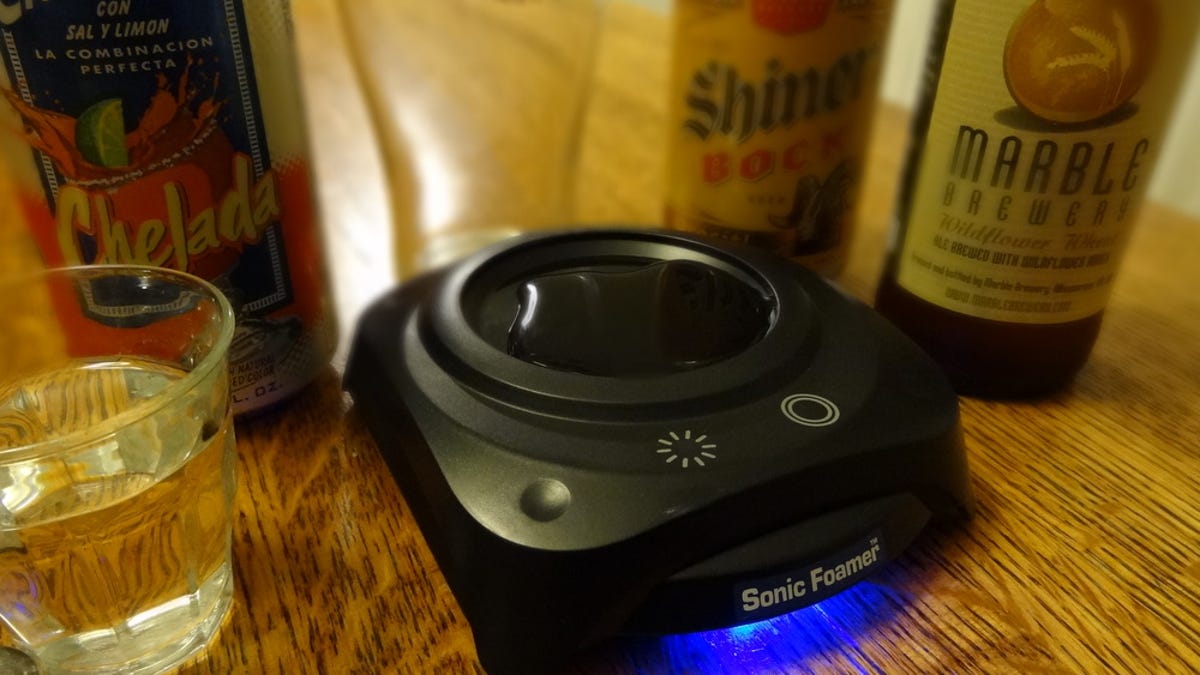Sonic Foamer blasts bubbles into your beer for flavor
The Sonic Foamer uses ultrasonic frequencies to shake up your beer, build the head, and boost the aroma. Crave tester Amanda Kooser downs a few extra beers for science.

Generally, Americans are trained to pour their beers down the side of a glass, minimizing the foam. The makers of the Sonic Foamer, a bubble-inducing beer gadget, are on a mission to change all that. The device claims to improve the flavor of beer by boosting the aroma through the power of ultrasonic frequencies.
The first thing I had to do before testing the $39.99 Sonic Foamer was get rid of my preconceived notions about avoiding a big head on a beer. I had to mentally embrace the foam. I then took the device over to the most expert beer taster I know: my home-brewing scientist brother.
You might recognize the Sonic Foamer as a gadget that first emerged in Japan under the name Sonic Hour. The American version works just like its overseas counterpart. You place six AA batteries into the device and turn it on. Pour two teaspoons of water into the tray, set a glass on top, and push the button to unleash an ultrasonic frequency that creates an upward blast of bubbles resulting in instant foam on top of your beer.
There are a few points to keep in mind. Be sure to use refrigerated beer and don't fill the glass more than 60 percent full. Otherwise you could have some mopping up to do.
There are already glasses on the market that produce a similar effect. My Samuel Smith glass, for example, is etched with a pattern on the bottom that creates a massive spiral of bubbles when you pour beer into it. Think of it as the analog counterpart to the Sonic Foamer.
A plain old thin-bottomed glass works best. I found one and set about foaming a local Albuquerque beer, Marble Brewery's Wildflower Wheat. My brother and I tasted the beer, first in a matching glass with no Foamer action, and then from a separate glass that had been goosed by the gadget.
We both noticed an intensification in the smell of the beer from all those extra particles shooting up from the surface. This continued with our next test subject, Shiner Bock. My brother felt the stronger aroma didn't necessarily add to the flavor, but I felt it amped up the tasting experience a bit. The scent blasts right up your noise after you foam it.
Of course, I wasn't going to let the Sonic Foamer off easy. I brought forth the greatest challenge the gadget has probably ever faced: Bud Light with Clamato, a substance so noxious the very thought of it causes my face to turn green. I wondered if there was any chance it could make it taste better.
So I pushed the button, listened to the high-pitched ping, and watched the red-tinged foam rise up... and promptly fall, brought down by the weight of the Clamato. And I took a sip. It was extreme, like the whole concoction was on steroids. My beer-connoisseur brother tried it. We both gagged. It's not that the Sonic Foamer failed; it's that it worked too well.
So how does the Sonic Foamer compare with that Samuel Smith foaming glass? They both create a healthy head on the beverage. The big advantage the technology has over the glass is that it doesn't suck all the bubbles out of the body of the beer, it still maintains the fizz.
Here's the upshot. If you're interested in getting an aroma boost for your beer, it will do that. Beers you already like will have an extra kick. Beers you already hate, you will hate even more. Please foam responsibly.

